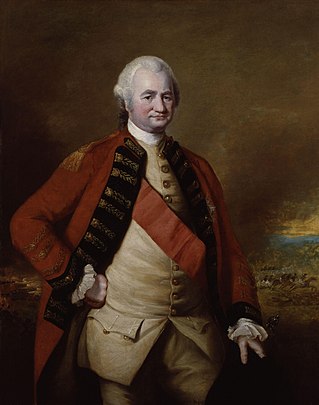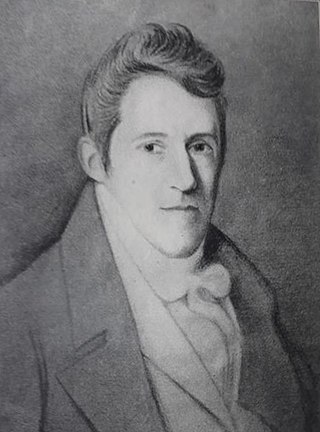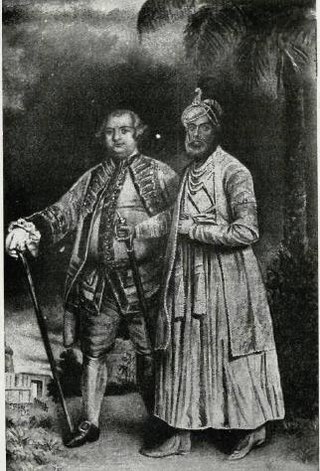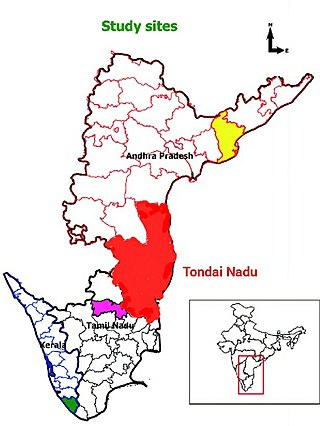
Robert Clive, 1st Baron Clive,, also known as Clive of India, was the first British Governor of the Bengal Presidency. Clive has been widely credited for laying the foundation of the British East India Company (EIC) rule in Bengal. He began as a writer for the EIC in 1744 and established Company rule in Bengal by winning the Battle of Plassey in 1757. In return for supporting the Nawab Mir Jafar as ruler of Bengal, Clive was guaranteed a jagir of £30,000 per year which was the rent the EIC would otherwise pay to the Nawab for their tax-farming concession. When Clive left India in January 1767 he had a fortune of £180,000 which he remitted through the Dutch East India Company.

The Madras Presidency or Madras Province, officially called the Presidency of Fort St. George until 1935, was an administrative subdivision (province) of India. At its greatest extent, the presidency included most of southern India, including all of Andhra Pradesh, almost all of Tamil Nadu and some parts of Kerala, Karnataka, Odisha and Telangana in the modern day. The city of Madras was the winter capital of the presidency and Ooty was the summer capital.

Thomas Parry was a Welsh merchant based in India. He was instrumental in establishing a trading company in Madras, India. Parry joined John William Dare to establish Parry & Dare in 1819 and this later became EID Parry company whose building gives the name of Parry's Corner, a well-known central business district of Chennai.
Telugu Brahmins are Telugu-speaking Brahmin communities native to the Indian states of Andhra Pradesh and Telangana. They fall under the Pancha Dravida Brahmin classification of the Brahmin community in India. Telugu Brahmins are further divided into sections like Vaidiki, Niyogi, Deshastha, Dravida and Golkonda Vyapari.

The Carnatic Wars were a series of military conflicts in the middle of the 18th century in India's coastal Carnatic region, a dependency of Hyderabad State, India. Three Carnatic Wars were fought between 1744 and 1763.
Dravida Brahmins, or simply Dravidulu, is a sub-caste of the Telugu Brahmins of Andhra Pradesh in South India, who migrated from Tamil-speaking regions. They are further divided into sub-sects based on the places where they have settled such as Aaraama Dravidulu, Pudur Dravidulu, Konaseema Dravidulu, Peruru Dravidulu, Tummagunta Dravidulu and Dimili Dravidulu.

The Carnatic Sultanate was a kingdom in South India between about 1690 and 1855, and was under the legal purview of the Nizam of Hyderabad, until their demise. They initially had their capital at Arcot in the present-day Indian state of Tamil Nadu. Their rule is an important period in the history of the Carnatic and Coromandel Coast regions, in which the Mughal Empire gave way to the rising influence of the Maratha Empire, and later the emergence of the British Raj.

Sa'adatullah Khan I or Sa'adatullah Khan was Nawab of Carnatic (r.1710–1732) and founder of Nawayath dynasty. He was an adventurer from Konkan in Maharashtra.
Joseph Collett (1673–1725) was a British administrator in the service of the British East India Company. He served as the deputy-governor of Bencoolen from 1712 to 1717 and as governor of the Madras Presidency from 1717 to 1720. He re-built Hertford Castle in England and stood for election to the British Parliament.

The Thanjavur Maratha kingdom ruled by the Bhonsle dynasty was a principality of Tamil Nadu between the 17th and 19th centuries. Their native language was Thanjavur Marathi. Venkoji was the founder of the dynasty.

Edward Harrison was a naval officer and official of the East India Company and British politician who sat in the House of Commons from 1717 to 1726. He served as the President of Madras from 11 July 1711 to 8 January 1717.
Francis Hastings was a British administrator and a factor of the British East India Company who functioned as the President of Madras from 18 January 1720 to 15 October 1721.

M. R. Ry. Ananda Ranga Pillai was a dubash in the service of the French East India Company.
Nathaniel Elwick was a British merchant who served as the President of Fort St. George from 15 October 1721 to 15 January 1725.

The Battle of Madras or Fall of Madras took place in September 1746 during the War of the Austrian Succession when a French force attacked and captured the city of Madras from its British garrison.

Madras Presidency was an administrative subdivision (presidency) of British India. At its greatest extent, Madras Presidency included much of southern India, including the present-day Indian State of Tamil Nadu, the Malabar region of North Kerala, Lakshadweep Islands, the Coastal Andhra and Rayalaseema regions of Andhra Pradesh, Brahmapur and Ganjam districts of Orissa and the Bellary, Dakshina Kannada, and Udupi districts of Karnataka. The presidency had its capital at Madras.

The First Carnatic War (1740–1748) was the Indian theatre of the War of the Austrian Succession and the first of a series of Carnatic Wars that established early British dominance on the east coast of the Indian subcontinent. In this conflict the British and French East India Companies vied with each other on land for control of their respective trading posts at Madras, Pondicherry, and Cuddalore, while naval forces of France and Britain engaged each other off the coast. The war set the stage for the rapid growth of French hegemony in southern India under the command of French Governor-General Joseph François Dupleix in the Second Carnatic War.

The siege of Trichinopoly was part of an extended series of conflicts between the Nizam of Hyderabad and the Maratha Empire for control of the Carnatic region. On 29 August 1743, after a six-month siege, Murari Rao surrendered, giving Nizam ul Mulk (Nizam) the suzerainty of Trichinopoly. By the end of 1743, the Nizam had regained full control of Deccan. This stopped the Maratha interference in the region and ended their hegemony over the Carnatic. The Nizam resolved the internal conflicts among the regional hereditary nobles (Nawabs) for the seat of governor (Subedar) of Arcot State, and monitored the activities of the British East India company and French East India Company by limiting their access to ports and trading.

The Bahram Jung Mosque is a mosque situated in the neighbourhood of Nandanam in Chennai, India. The mosque was constructed between 1789 and 1795 by Muhammad Abdullah Qadir Nawaz Khan Bahadur Bahram Jung, a poet in the court of Muhammad Ali Khan Wallajah, the Nawab of the Carnatic.

Tondaimandalam, also known as Tondai Nadu, is a historical region located in the northernmost part of Tamil Nadu and southernmost part of Andhra Pradesh. The region comprises the districts which formed a part of the legendary kingdom of Athondai Chakravarti. The boundaries of Tondaimandalam are ambiguous – between the river basins of Penna River and Ponnaiyar River. During the reign of Rajaraja I, this region was called as Jayankonda Cholamandalam.